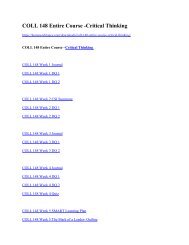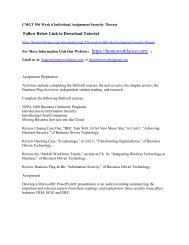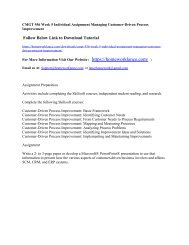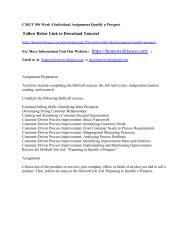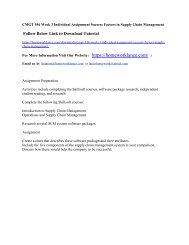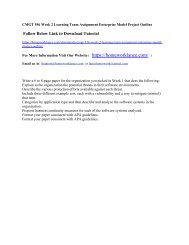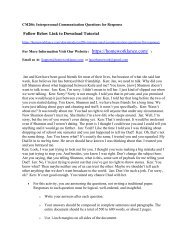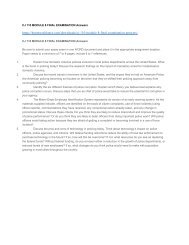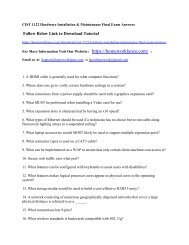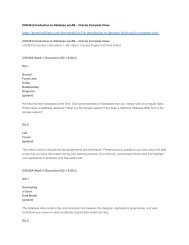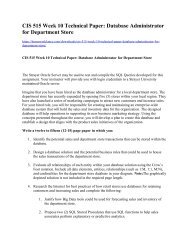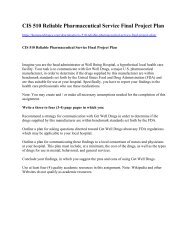CJ415 Final Exam 100% Correct Answers
Create successful ePaper yourself
Turn your PDF publications into a flip-book with our unique Google optimized e-Paper software.
<strong>CJ415</strong> <strong>Final</strong> <strong>Exam</strong> <strong>100%</strong> <strong>Correct</strong> <strong>Answers</strong><br />
Follow Below Link to Download Tutorial<br />
https://homeworklance.com/downloads/cj415-final-exam-100-correct-answers/<br />
For More Information Visit Our Website ( https://homeworklance.com/ )<br />
Email us At: Support@homeworklance.com or lancehomework@gmail.com<br />
The ________ hypothesis regarding crime argues that as a country undergoes economic<br />
development, its crime rate increases.<br />
slippery slope<br />
globalization<br />
modernization<br />
transnational<br />
crime<br />
2 points<br />
Question 2<br />
Generally, the police forces of any given country are much more likely to be dealing with<br />
___________ crime and much less likely, if ever, to be dealing with _________ crime.<br />
transnational,<br />
international<br />
international,<br />
transnational<br />
national,<br />
global<br />
organized,<br />
international<br />
2 points<br />
Question 3
Offenses, whose inception, prevention, and/or direct or indirect effects involved more than one<br />
country is an example of:<br />
international<br />
transnational<br />
global<br />
world<br />
2 points<br />
Question 4<br />
The process used by criminals to convert funds acquired illegally into what appears to be<br />
legitimate income that can the used for legal purposes such as investment and purchase, is an<br />
example of:<br />
bank fraud<br />
drug<br />
trafficking<br />
money<br />
laundering<br />
corruption<br />
2 points<br />
Question 5<br />
The movement of mood altering substances from their points of origin to their points of<br />
consumption is an example of:<br />
drug<br />
trafficking<br />
drug<br />
laundering<br />
drug<br />
distribution<br />
corruption<br />
2 points<br />
Question 6
Although not in itself a crime, buying a legal business may be deemed ________, if it is used a<br />
means for laundering money that may have been acquired illegally.<br />
criminal<br />
illegal<br />
unethical<br />
morally<br />
wrong<br />
2 points<br />
Question 7<br />
_______ crimes call for a great deal of ingenuity and versatility on the part of law enforcement<br />
in terms of learning, investigation, and prevention.<br />
sex<br />
cyber<br />
drug<br />
victimless<br />
2 points<br />
Question 8<br />
Most victims of __________ theft are likely to be looking for recompense, and not criminal<br />
punishment, and therefore, not generally likely to involve police agencies.<br />
identity<br />
intellectual<br />
property<br />
property<br />
vehicle<br />
2 points<br />
Question 9
____________ may be localized or may operate transnationally.<br />
drug<br />
trafficking<br />
illegal<br />
arms sales<br />
terrorism<br />
identity<br />
theft<br />
2 points<br />
Question 10<br />
The illegal commandeering of ________ for the purpose of either demanding ransom payments<br />
or for making a political statement has been a feature of much of the late twentieth century.<br />
watercraft<br />
trains<br />
subway<br />
cars<br />
airplanes<br />
2 points<br />
Question 11<br />
_____________ is an age-old offense, which is considered the first to result in multinational<br />
cooperative law enforcement efforts continues to exist in certain parts of the world, particularly<br />
in and around Central and South America, Southeast Asia, and West Africa.<br />
aircraft<br />
hijacking<br />
sea<br />
piracy<br />
terrorism<br />
treason<br />
2 points<br />
Question 12
___________ is defined as the procurement of illegal entry of a person into a state of which the<br />
latter person is not a national with the objective of making a profit.<br />
illegal<br />
immigration<br />
prostitution<br />
human<br />
smuggling<br />
spying<br />
2 points<br />
Question 13<br />
Transnational ____________ crime is a fact of contemporary life.<br />
drug<br />
environmental<br />
illegal arms<br />
terrorism<br />
2 points<br />
Question 14<br />
Over the past 20 years, there has been a growing preoccupation with ____________ crime.<br />
transnational<br />
drug<br />
gang<br />
organized<br />
2 points<br />
Question 15<br />
The most discussed and least understood international police organization in the world is:
EUROPOL<br />
CIA<br />
INTERPOL<br />
BATFE<br />
2 points<br />
Question 16<br />
The _________ by the police can be defined as occurring “any time the police attempt to have<br />
citizens act in a certain way.”<br />
brutality<br />
use of<br />
force<br />
authority<br />
corruption<br />
2 points<br />
Question 17<br />
Incidents of police use of excessive force have included all except:<br />
deliberate<br />
choking<br />
beating<br />
civil rights<br />
protesters<br />
handcuffing<br />
deliberate<br />
kicking<br />
2 points<br />
Question 18<br />
The philosophy of __________ police officers in which the police subculture becomes a way of<br />
life can thus lead to police misconduct.
other<br />
and<br />
sister<br />
us vs.<br />
them<br />
we<br />
have<br />
the<br />
power<br />
I am<br />
the law<br />
2 points<br />
Question 19<br />
In the twentieth century, the United States Supreme Court, to protect citizens from governmental<br />
abuses from the states and their agents, extended the Bill of Rights to be applicable to the _____.<br />
police<br />
local<br />
governments<br />
states<br />
people<br />
2 points<br />
Question 20<br />
The police __________ is an extreme version of a phenomenon that exists in many human<br />
groups.<br />
subculture<br />
thin blue<br />
line<br />
corruption<br />
code of<br />
silence<br />
2 points
Question 21<br />
Many people, specifically _________, believe that the police are often engaged in excessive and<br />
unnecessary physical force.<br />
government<br />
officials<br />
minority<br />
groups<br />
older<br />
citizens<br />
youth<br />
2 points<br />
Question 22<br />
Some forms of police brutality have also been referred to as _________.<br />
the third<br />
degree<br />
throwing<br />
the book<br />
at them<br />
hazing<br />
us vs.<br />
them<br />
2 points<br />
Question 23<br />
What made the King-beating incident significantly different from earlier alleged incidents of<br />
police brutality was that a private citizen __________ this incident.<br />
videotaped<br />
reported<br />
helped<br />
officers in
helped<br />
King in<br />
2 points<br />
Question 24<br />
The police can trace their authority to use _______ back to the Common Law of England, which<br />
was developed during the Middle Ages.<br />
less than<br />
lethal<br />
force<br />
deadly<br />
force<br />
weapons<br />
2 points<br />
Question 25<br />
In 1986, the U.S. Supreme Court struck down the fleeing felon rule, which allowed police<br />
officers to use deadly force, i.e., to shoot to kill a suspect escaping from the scene of a crime.<br />
This historical case is:<br />
Brandenburg<br />
v. Ohio<br />
Tennessee v.<br />
Gardner<br />
Miranda v.<br />
Arizona<br />
Mapp v.<br />
Ohio<br />
2 points<br />
Question 26
Dysfunctional behavior such as police violence comes about when looking at police brutality<br />
from a ___________ perspective.<br />
conflict<br />
theorist<br />
functionalist<br />
interactionist<br />
emergent<br />
theorist<br />
2 points<br />
Question 27<br />
The __________ perspective takes a critical stance and believes that the police represent the<br />
group that has power, prestige, and wealth in a given society.<br />
interactionist<br />
fundamentalist<br />
conflict<br />
democratic<br />
2 points<br />
Question 28<br />
From a ____________ perspective, a lot of attention would be devoted to considering the nature<br />
and meanings of acts that are defined as police brutality or excessive use of force.<br />
conflict<br />
interactionist<br />
functionalist<br />
classical<br />
2 points<br />
Question 29
Based on a perceived increase in police violence, a ___________________ was established by<br />
the Israeli police in 1992.<br />
civilian<br />
complaint<br />
board<br />
commission<br />
of law<br />
enforcement<br />
abuse<br />
zero<br />
tolerance<br />
policy<br />
law<br />
prohibiting<br />
excessive<br />
force<br />
2 points<br />
Question 30<br />
One whose members, because of physical or cultural characteristics, are disadvantaged and<br />
subjected to unequal treatment by the dominant group and who regard themselves as objects<br />
of collective discrimination is the definition of a:<br />
subordinate<br />
group<br />
subculture<br />
parent<br />
group<br />
dominant<br />
group<br />
2 points<br />
Question 31<br />
A __________ group is one that is advantaged and has superior resources and rights in a society.<br />
suburbanite
sub<br />
dominate<br />
focus<br />
2 points<br />
Question 32<br />
__________ refers to an attitude that evaluates an individual member of a subordinate group<br />
negatively on the basis of certain negative characteristics that are associated with that group even<br />
if the individual does not conform to those expected characteristics.<br />
racism<br />
prejudice<br />
racial<br />
profiling<br />
ethnic<br />
bias<br />
2 points<br />
Question 33<br />
One who harbors negative attitudes toward any particular subordinate group and will act<br />
negatively toward them can be referred to as a:<br />
unprejudiced<br />
nondiscriminator<br />
apartheid<br />
prejudiced<br />
discriminator<br />
subordinate<br />
group<br />
2 points<br />
Question 34
The most common pattern, based on perceived biological differences such as skin color,<br />
complexion, hair color, and or eye color is referred to as _________.<br />
racism<br />
prejudiced<br />
discriminator<br />
ethnic bias<br />
sexism<br />
2 points<br />
Question 35<br />
Prejudice and discrimination that is based on cultural differences among groups, sometimes even<br />
if they are of the same race is the definition of:<br />
racial<br />
profiling<br />
ethnic bias<br />
prejudice<br />
discrimination<br />
2 points<br />
Question 36<br />
The pattern of prejudice and discrimination that negatively targets either the young or the elderly<br />
is known as:<br />
discrimination<br />
ethnic bias<br />
apartheid<br />
ageism<br />
2 points<br />
Question 37
__________ is defined as a fairly rigid, oversimplified view or image of a particular social group<br />
that is then applied to individuals who belong to that group.<br />
ageism<br />
stereotyping<br />
heterosexism<br />
ethnic bias<br />
2 points<br />
Question 38<br />
A process by which members of subordinate groups are blamed for the problems and frustrations<br />
experienced by members of the dominant group is an example of:<br />
scapegoating<br />
stereotyping<br />
ethnic bias<br />
cultural<br />
diversity<br />
2 points<br />
Question 39<br />
Societies that are made up of more than one ethnic group are referred to as:<br />
dominate<br />
societies<br />
diverse<br />
societies<br />
plural<br />
societies<br />
multicultural<br />
societies<br />
2 points<br />
Question 40
When women are treated less harshly than male suspects by the police and the criminal justice<br />
system given traditional gender expectations and notions of them being the “weaker sex”, we are<br />
defining:<br />
sexism<br />
chivalry<br />
hypothesis<br />
stereotyping<br />
sexual bias<br />
2 points<br />
Question 41<br />
Conduct which the people of a group are considered so dangerous or embarrassing or irritating<br />
that they bring special sanctions to bear against the persons who exhibit it is an example of:<br />
deviance<br />
police<br />
misconduct<br />
use of<br />
force<br />
corruption<br />
2 points<br />
Question 42<br />
_____________ is when individuals who happen to be in the police force engage in activities<br />
that violate departmental policies, laws, and social norms and misuse the powers of their office.<br />
corruption<br />
occupational<br />
deviance<br />
deviance<br />
organizational<br />
deviance<br />
2 points<br />
Question 43
_____________ has been coined by sociologists to encompass serious situations occurring<br />
within entire organization. This behavior includes police brutality and corruption.<br />
occupational<br />
deviance<br />
the slippery<br />
slope<br />
organizational<br />
deviance<br />
deviance<br />
2 points<br />
Question 44<br />
___________ was a New York City police officer in the 1970s who fought against corruption.<br />
Donnie<br />
Brasco<br />
Frank<br />
Serpico<br />
Joe<br />
Pistone<br />
O.W.<br />
Wilson<br />
2 points<br />
Question 45<br />
The ________ requires that police officers look the other way when they observe their fellow<br />
officers involved in acts of deviance.<br />
thin blue<br />
line<br />
code of<br />
the<br />
streets<br />
informal
handbook<br />
code of<br />
silence<br />
2 points<br />
Question 46<br />
___________ can be explained as receiving money or some monetary gain for not performing a<br />
legal duty or responsibility by a police officer.<br />
organizational<br />
deviance<br />
corruption<br />
occupational<br />
deviance<br />
the slippery<br />
slope<br />
2 points<br />
Question 47<br />
In the late 1990s, the ________________ experienced a corruption scandal that made national<br />
and international headlines.<br />
New York<br />
PD<br />
Los Angeles<br />
PD<br />
Chicago PD<br />
Philadelphia<br />
PD<br />
2 points<br />
Question 48
____________ are payments in the form of money, goods, or services that a law enforcement<br />
agent receives for directing people, that he or she comes in contact with, toward a particular<br />
service provider.<br />
kickbacks<br />
payoffs<br />
bribes<br />
internal<br />
payoffs<br />
2 points<br />
Question 49<br />
In the approximately 160-year history of the NYPD a major corruption scandal seems to occur<br />
approximately every _____ years.<br />
10<br />
20<br />
15<br />
30<br />
2 points<br />
Question 50<br />
A grass eater is a officer who:<br />
does not<br />
actively<br />
seek out<br />
gratuities<br />
seeks out<br />
gratuities<br />
takes<br />
complaints<br />
to internal<br />
affairs<br />
refuses to<br />
accept<br />
gratuities
2 points



